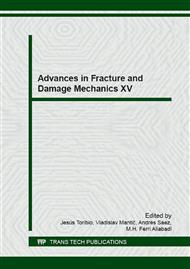[4]
Table 2 shows the determined parameters for different test setups. The values of the 95%-confidence interval are written in brackets. The number of specimens tested for each setup is 30. Table 2: Determined parameters for Weibull distribution Ra in mm σ0 in MPa m B3B.
Google Scholar
[21]
74 (20. 01 | 23. 67).
Google Scholar
[4]
88 (3. 57 | 6. 56) B3B.
Google Scholar
[21]
35 (19. 66 | 23. 25).
Google Scholar
[4]
88 (3. 57 | 6. 57) B3B.
Google Scholar
[20]
56 (19. 02 | 22. 28).
Google Scholar
[5]
18 (3. 79 | 6. 97) SPT.
Google Scholar
[19]
06 (17. 61 | 20. 57).
Google Scholar
[5]
29 (3. 88 | 7. 13) The parameters are independent from the test setup, if the Weibull strength is referring to the same effective volume. Otherwise, the highest strength would be evaluated for the smallest effective volume because of the size dependence of the strength of ceramic materials, where volume defects causing fracture. Assessment of fracture toughness With the help of both B3B experimental data and finite element analyses a first estimation of the fracture toughness is performed. A 3D-FE-model was generated under the assumption that three cracks initiate in the direction of the highest tensile stresses. Because of the geometrical symmetries only a sixth part of the specimen is considered and the fracture process zone is modelled as a cohesive zone, see Figure2. A bilinear cohesive law is implemented. The cohesive traction tn and corresponding separation sn is a constitutional assumption. To describe this behavior the parameters cohesive strength t0, cohesive stiffness K and separation energy G0 are required. RP1 x y z z' x' y' continuum cohesive elements x y z RP2 u tn sn t0 s0 sf 0 K G0 Figure 2: Frontview and topview of B3B model (left) and bilinear cohesive law (right) These parameters are identified by minimizing the difference between force-displacement curves of experiment and simulation. The results for different geometries of the B3B are shown in Figure 3 and Table 3. For experiments where three cracks are obtained, a parameter identification is performed. The force-displacement curves are analyzed up to the first load drop. Then the fracture toughness KIC is estimated by KIC=G0E' with E'=E E1-ν2 for plane stress statefor plane strain state. (3) Table 3: Results of parameter identification Ra in mm.
Google Scholar
[3]
46 E in MPa 5930 6022 8067 G0 in N/mm.
Google Scholar
45 Figure 3: Force-displacement curve for experiment and simulation Conclusion By means of a Weibull distribution a correlation between strength and failure probability could be determined for the material investigated. SPT and B3B show comparable results when referring to the same effective volume. Because of the advantages of the B3B this test setup is to be favored. With the help of a cohesive zone model the fracture toughness of the carbon bonded alumina is estimated within the described assumptions. However, these results have to be analyzed carefully and require a validation with other experimental investigations. Furthermore, only experiments at room temperature are performed, whereas the filter has to withstand high temperatures during casting process. Hence, further investigations are necessary to determine temperature dependent fracture mechanical properties. Acknowledgement The financial support for H. Zielke and M. Abendroth by the German Research Foundation (DFG) within the collaborative research center CRC920 is gratefully acknowledged. The authors appreciate the help of A. Schmidt (IKGB) and D. Schmidt (IMFD) with the specimen preparation. Literature.
Google Scholar
[1]
M. Emmel and C.G. Aneziris. Ceramics International, 38(6): 5165-5173, (2012).
Google Scholar
[2]
A. Börger, P. Supancic, and R. Danzer. Journal of the European Ceramic Society, 22: 1425-1436, (2002).
Google Scholar
[3]
D. Munz and T. Fett. Ceramics Mechanical Properties, Failure Behaviour, Materials Selection. Springer, (1999).
DOI: 10.1007/978-3-642-58407-7
Google Scholar
[4]
DIN EN 843-5: 2006 Advanced technical ceramics - Mechanical properties of monolithic ceramics at room temperature - Part 5: Statistical analysis.
DOI: 10.3403/30125778u
Google Scholar


